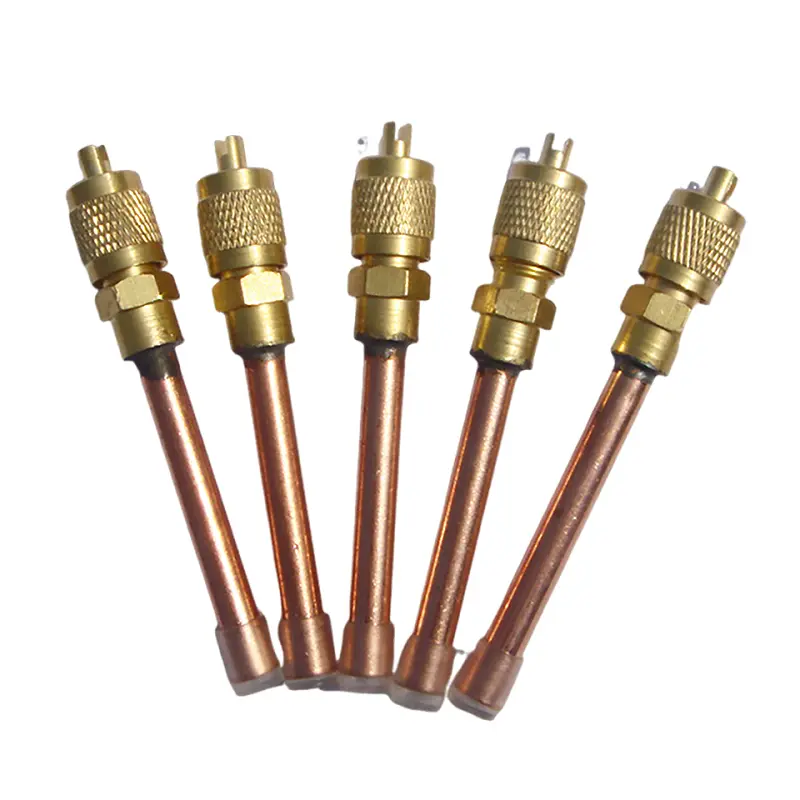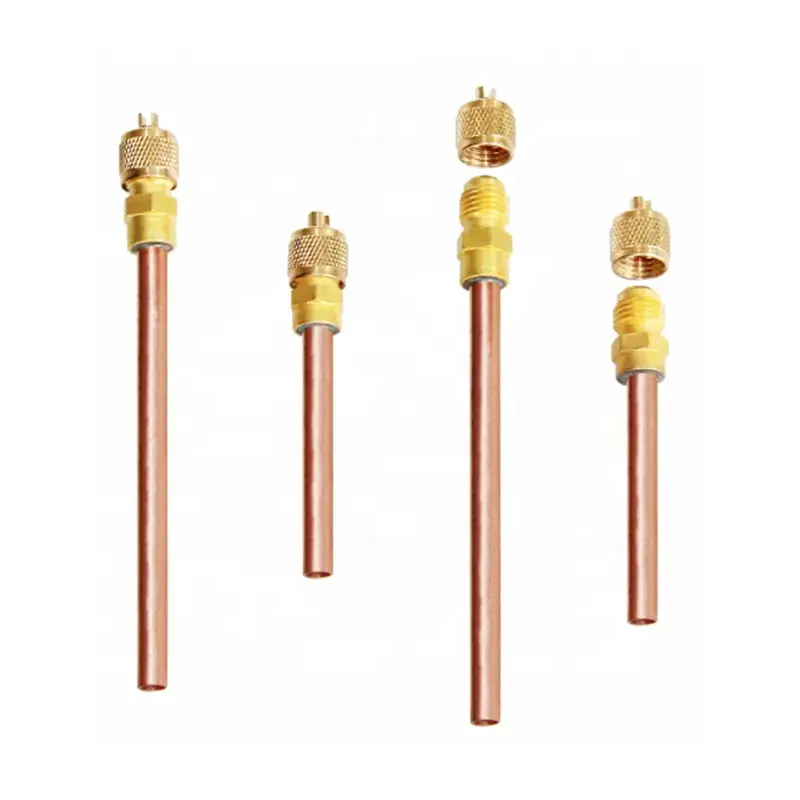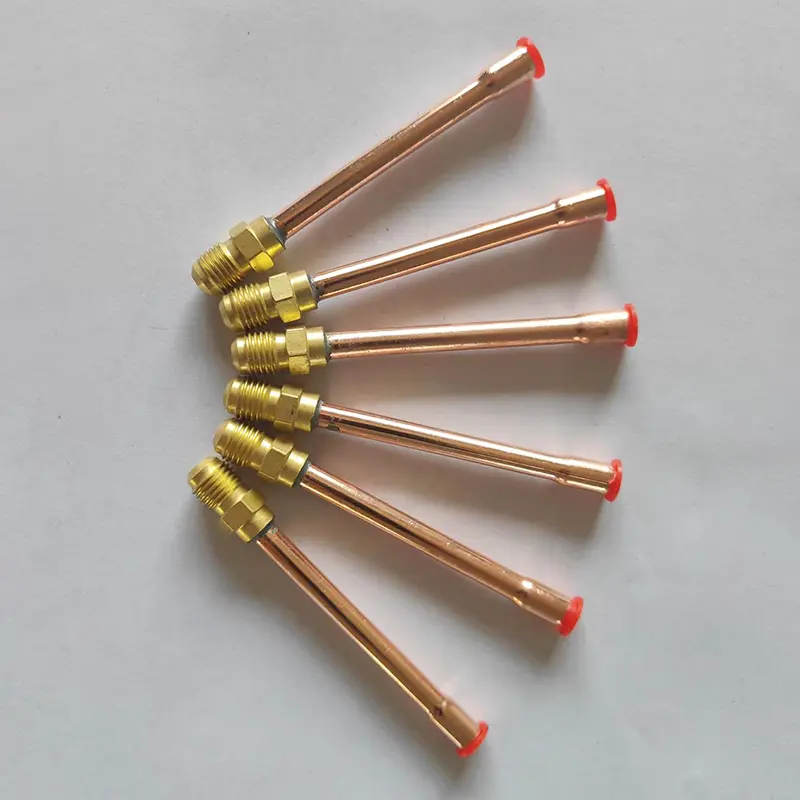Author:
-
Position:
General Manager of Foreign Trade Department, Taojun Refrigeration -
Professional Experience:
Engaged in international trade within the refrigeration industry since 2004.
Expert in brand strategy and omni-channel marketing, having led three multi-million yuan projects that boosted brand exposure by over 200%.
-
Core Competencies:
Proficient in data analysis and user growth strategies.
Skilled in SEO/SEM and social media management tools.
Experienced in cross-departmental collaboration and team leadership.
-
Philosophy:
"Data-driven decisions, creativity-powered branding." Committed to achieving business value and user experience excellence through refined operations. -
Vision:
Eager to collaborate with partners to explore emerging market opportunities and set industry benchmark cases.
Contact Us to Find More Products
How to Maintain Refrigeration Systems with Charging Valves

charging valves play a pivotal role in refrigeration systems by regulating refrigerant levels and pressure, ensuring efficient operation. These valvesminimize pressure surgesthat can overload compressors and reduce transient conditions by aligning with load requirements. Unlike traditional piloted control valves, which depend on a pressure differential to function, modern charging valves operate independently, enhancing reliability. Incorporating components like the Air Conditioning Fitting Charging Hose Safety Valve further improves safety and performance. By maintaining optimal refrigerant flow, charging valves significantly contribute to the system's efficiency and longevity, making them an indispensable part of refrigeration maintenance.
Key Takeaways
- Check charging valves often to find leaks or damage. This keeps the system working well and avoids expensive fixes.
- Use good-quality charging valves, like Taojun HVAC ones, for steady refrigerant flow and fewer problems.
- Install charging valves correctly to stop refrigerant from flowing backward and to keep pressure balanced.
- Watch refrigerant levels and pressure regularly to spot problems early. This keeps cooling strong and saves energy.
- Add safety valves during maintenance to stop refrigerant from leaking by accident. This keeps workers safe and improves the system.
Understanding Charging Valves

What Are Charging Valves?
Charging valves, also referred to as Access Valves, are critical components in refrigeration and air conditioning systems. These valves regulate the flow of refrigerants, ensuring that the system maintains optimal pressure and temperature levels. Designed with precision, charging valves allow technicians to add or remove refrigerant during maintenance or repair tasks without disrupting the system's operation.
The construction of a charging valve typically includes a durable housing, a valve needle, and a sealing mechanism. Taojun HVAC’s charging valves, for instance, feature a nylon valve needle and double-sealing technology to prevent leaks. Directional arrows on the valve’s exterior simplify installation by indicating the correct flow direction. This ensures proper alignment with the system’s refrigerant flow, reducing the risk of errors during setup.
Charging valves are versatile and adaptable to various refrigerants, including HCFC and HFC types. Their robust design enables them to withstand high pressures and temperatures, making them suitable for both residential and industrial applications. By incorporating these valves, refrigeration systems achieve greater reliability and efficiency.
How Do Charging Valves Enhance Refrigeration Efficiency?
Charging valves play a pivotal role in maintaining the efficiency of refrigeration systems. They prevent backflow of high-pressure vapor from the compressor into the evaporator when the system is idle. This backflow, if unchecked, can elevate the evaporator’s temperature, reducing the system’s cooling performance.
By facilitating precise control of refrigerant flow, charging valves help balance high and low pressures within the system. This balance ensures a smooth restart of the compressor, minimizing energy consumption and wear on system components. Additionally, the unidirectional flow mechanism safeguards the system from pressure surges, which could otherwise damage sensitive parts.
Tip: Using high-quality charging valves, such as those from Taojun HVAC, ensures long-term reliability and optimal performance. Their advanced features, like double sealing and compatibility with various refrigerants, make them a preferred choice for HVAC professionals.
Common Refrigeration Efficiency Problems
Issues Caused by Improper Refrigerant Levels
Refrigerant levels play a critical role in the performance of refrigeration systems. When refrigerant levels deviate from the recommended range, the system's efficiency and reliability suffer. Low refrigerant levels often result in insufficient cooling, causing the compressor to overwork. This excessive strain can lead to premature wear and increased energy consumption. Conversely, overcharging the system with refrigerant can create high-pressure conditions, potentially damaging components like the compressor and condenser.
Improper refrigerant levels also disrupt the balance between high and low pressures within the system. This imbalance can cause temperature fluctuations, leading to inconsistent cooling performance. For instance, a poorly maintained system may struggle to maintain the desired temperature in a commercial refrigeration unit, affecting product quality and customer satisfaction.
Note: A well-maintained charging valve, such as those offered by Taojun HVAC, ensures precise refrigerant flow, helping to maintain optimal levels and prevent these issues.
Problems Linked to Faulty Charging Valves
Faulty charging valves can significantly impact the efficiency and safety of refrigeration systems. A damaged or leaking valve may allow refrigerant to escape, reducing the system's cooling capacity and increasing operational costs. Leaks also pose environmental risks, as many refrigerants contribute to greenhouse gas emissions.
In addition to leaks, a malfunctioning charging valve may fail to regulate refrigerant flow properly. This can lead to backflow, where high-pressure vapor from the compressor enters the evaporator. Such backflow raises the evaporator's temperature, reducing the system's overall efficiency. Over time, this inefficiency can result in higher energy bills and more frequent maintenance requirements.
A documented case study highlights the importance of addressing these issues promptly. Improved collaboration between contractors and manufacturers minimized delays during system commissioning, saving up to $250,000 per day in lost sales. Similarly, robust refrigeration systems with enhanced quality control increased system longevity and reduced maintenance costs, avoiding $150,000 heater replacements.
| Challenge | Solution | Result |
|---|---|---|
| Communication issues between contractors and manufacturers | Improved collaboration and commissioning protocols | Minimized delays, saving up to $250,000 per day in lost sales |
| Reliability of systems | Designed robust refrigeration systems with enhanced quality control | Increased system longevity and reduced maintenance costs, avoiding $150,000 heater replacements |
"Every day we aren’t pushing product costs us between $156,000 and $250,000 at a hub. Zero Zone helped minimize these delays by collaborating on the startup process."
To mitigate these problems, technicians should inspect charging valves regularly for signs of wear or damage. Using high-quality components, such as the Air Conditioning Fitting Charging Hose Safety Valve, further enhances system safety and performance. This safety valve prevents accidental refrigerant discharge during maintenance, ensuring a secure and efficient operation.
Steps to Maintain Refrigeration Systems with Charging Valves

Inspecting Charging Valves for Damage or Leaks
Regular inspection of charging valves ensures the integrity and efficiency of refrigeration systems. Technicians should follow a systematic approach to identify potential issues such as leaks, physical damage, or operational inefficiencies. A damaged valve can compromise refrigerant flow, leading to reduced cooling performance and increased energy consumption.
- Check Caps: Verify that caps are securely in place and gaskets remain intact to prevent leaks.
- Inspect Threads: Ensure connection threads are free from damage to maintain a tight seal.
- Valve Handle: Confirm the handle is functional and not broken.
- Check for Leaks: Use leak detection tools to identify refrigerant escape points.
- Operational Test: Open and close the valve fully to ensure smooth operation without resistance.
| Inspection Step | Description |
|---|---|
| Check Caps | Ensure caps are in place and gaskets are intact. |
| Inspect Threads | Verify that connection threads are undamaged. |
| Valve Handle | Confirm that the valve handle isn’t broken. |
| Check for Leaks | Ensure the valve isn’t leaking. |
| Operational Test | Fully open and close the valve to check smooth operation. |
Tip: Incorporating the Air Conditioning Fitting Charging Hose Safety Valve during inspections enhances system safety by preventing accidental refrigerant discharge.
Proper Installation of Charging Valves
Proper installation of charging valves is critical for maintaining system efficiency and preventing operational issues. Manufacturers recommend adhering to specific guidelines to ensure optimal performance. Incorrect installation can lead to refrigerant backflow, pressure imbalances, or valve damage.
Technicians should follow these steps for effective installation:
- Use sizing software to account for worst-case operating conditions.
- Factor in piping reducer effects on flow coefficients.
- Select valve location and type to minimize damage from flashing.
- Prefer sliding stem valves to reduce backlash and stiction.
- For rotary valves, choose models with splined shafts and minimal seal friction.
- Use Teflon or Ultra Low Friction (ULF) packing for higher temperature ranges.
- Compute valve flow characteristics for extreme conditions.
- Size actuators to deliver at least 150% of required torque or thrust.
- Select actuators and positioners with sensitivities of 0.1% or better.
- Ensure total valve assembly dead band remains below 0.4% across the throttle range.
Note: Taojun HVAC’s charging valves feature directional arrows on their exterior, simplifying installation by indicating the correct refrigerant flow direction.
Monitoring Refrigerant Levels and Pressure
Monitoring refrigerant levels and pressure is essential for maintaining system efficiency and preventing costly breakdowns. Accurate tracking helps identify issues such as leaks, overcharging, or undercharging, which can disrupt cooling performance and increase energy consumption.
Technicians can use the following techniques to monitor refrigerant levels effectively:
- System Performance Monitoring: Track cooling efficiency and temperature differentials to detect pressure-related issues.
- Utilize Diagnostic Software: Employ software for real-time data and alerts on refrigerant pressure deviations.
- System Diagnostics: Compare measured pressures against standard conditions to identify malfunctions.
- Regular Pressure Checks: Use gauges to monitor high and low sides of the system routinely.
- Preventive Maintenance: Conduct routine pressure measurements to identify potential problems early.
- Advanced Monitoring Systems: Implement systems that provide real-time data and alerts for pressure deviations.
- Temperature Correction: Use pressure-temperature charts to correlate readings with temperature for accurate interpretation.
| Technique | Description |
|---|---|
| System Performance Monitoring | Track cooling efficiency and temperature differentials to identify refrigerant pressure issues. |
| Utilize Diagnostic Software | Employ software for real-time data and alerts on pressure-related issues. |
| System Diagnostics | Compare measured pressures against standard conditions to identify leaks or malfunctions. |
| Regular Pressure Checks | Use gauges for routine checks on high and low sides of the system. |
| Preventive Maintenance | Routine pressure measurement to identify potential problems early. |
| Advanced Monitoring Systems | Implement systems that provide real-time data and alerts for pressure deviations. |
| Temperature Correction | Use pressure-temperature charts to correlate readings with temperature for accurate interpretation. |
Tip: Using high-quality components like the Air Conditioning Fitting Charging Hose Safety Valve ensures secure connections during monitoring, reducing the risk of erroneous readings.
Preventative Maintenance Tips
Regular System Inspections
Regular inspections are essential for maintaining refrigeration systems' efficiency and longevity. Technicians should follow a structured schedule to identify potential issues early. For example, adhering to manufacturer-recommended maintenance intervals ensures that critical components are evaluated before they fail. Digital inspection checklists can further enhance this process by providing a systematic framework, ensuring no step is overlooked. These checklists also promote accountability and help maintain accurate maintenance records.
Experts recommend focusing on key areas during inspections, such as refrigerant levels, valve integrity, and system pressure. Early detection of issues like refrigerant leaks or worn-out components can prevent costly repairs and extend the system's lifespan. Routine servicing also ensures that the system operates at peak efficiency, reducing energy consumption and operational costs.
| Strategy | Description |
|---|---|
| Regular Assessments | Identifying parts nearing the end of their useful life through qualified technician evaluations. |
| Scheduled Maintenance | Budgeting for routine check-ups to catch problems early, reducing future repair costs. |
| Predictive Maintenance | Using data analysis to forecast potential breakdowns based on operational parameters and historical data. |
| Training for Maintenance Personnel | Ensuring maintenance staff are skilled for effective upkeep of refrigeration systems. |
| Early Detection of Issues | Spotting issues like refrigerant leaks early to prevent significant failures. |
| System Efficiency | Keeping systems running efficiently through routine checks, such as cleaning coils and lubricating parts. |
Tip: Incorporating structured inspection schedules and digital tools can significantly improve system reliability and performance.
Using High-Quality Charging Valves from Taojun HVAC
High-quality charging valves play a pivotal role in maintaining refrigeration systems. Taojun HVAC’s charging valves, designed with advanced features like double sealing and directional flow indicators, ensure precise refrigerant control. These valves prevent backflow, safeguard system components, and maintain optimal pressure levels. Their compatibility with various refrigerants, including HCFC and HFC types, makes them suitable for diverse applications.
Using premium components like Taojun HVAC’s charging valves reduces the risk of leaks and operational inefficiencies. Their robust construction ensures durability, even in demanding environments. By investing in high-quality valves, technicians can enhance system reliability, minimize maintenance needs, and extend the equipment’s lifespan.
Note: Proper installation and regular inspections of charging valves further optimize their performance, ensuring long-term system efficiency.
Importance of Air Conditioning Fitting Charging Hose Safety Valve
The Air Conditioning Fitting Charging Hose Safety Valve is a critical component for safe and efficient refrigeration system maintenance. This valve prevents accidental refrigerant discharge during servicing, reducing environmental risks and ensuring technician safety. Compliance with industry standards, such as SAE J639 and SAE J2844, underscores its importance in professional HVAC operations.
Safety studies highlight the necessity of features like high-pressure cutoff switches and pressure relief devices in modern systems. The Air Conditioning Fitting Charging Hose Safety Valve aligns with these requirements, offering a secure connection during refrigerant handling. Its integration into maintenance routines not only enhances safety but also improves system performance by preventing refrigerant loss.
Tip: Incorporating safety valves into refrigeration systems ensures compliance with industry standards and promotes safe maintenance practices.
Regular maintenance of charging valves is essential for addressing refrigeration efficiency challenges. By prioritizing inspections, proper installations, and consistent monitoring, technicians can ensure systems operate at peak performance. These practices not only enhance cooling efficiency but also extend the lifespan of critical components.
Key Takeaway: Proactive maintenance of charging valves prevents costly repairs and ensures reliable operation. Investing in high-quality valves, such as those from Taojun HVAC, further optimizes system performance and safety.
FAQ
What is the primary function of a charging valve in refrigeration systems?
A charging valve regulates refrigerant flow, ensuring optimal pressure and temperature levels. It prevents backflow, maintains system efficiency, and allows technicians to add or remove refrigerant during maintenance without disrupting operations.
How often should charging valves be inspected?
Technicians should inspect charging valves during routine maintenance, typically every three to six months. Regular inspections help identify leaks, damage, or operational inefficiencies, ensuring the refrigeration system operates efficiently and reliably.
Can charging valves be used with all refrigerants?
Most charging valves, including those from Taojun HVAC, are compatible with HCFC and HFC refrigerants. Always verify the valve's specifications to ensure compatibility with the refrigerant used in your system.
Why is proper installation of charging valves important?
Proper installation ensures the valve aligns with the refrigerant flow direction, preventing backflow and pressure imbalances. Incorrect installation can lead to system inefficiencies, refrigerant loss, or damage to components.
What safety measures should technicians follow when handling charging valves?
Technicians should use tools like the Air Conditioning Fitting Charging Hose Safety Valve to prevent accidental refrigerant discharge. Wearing protective gear and adhering to industry standards ensures safe and efficient maintenance practices.
Tip: Always follow manufacturer guidelines for installation and maintenance to maximize safety and performance.








